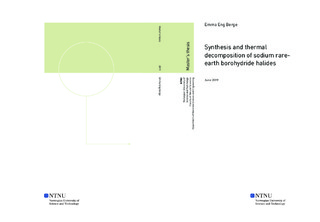| dc.contributor.advisor | Grande, Tor | |
| dc.contributor.author | Emma Eng Berge | |
| dc.date.accessioned | 2019-10-24T14:00:54Z | |
| dc.date.available | 2019-10-24T14:00:54Z | |
| dc.date.issued | 2019 | |
| dc.identifier.uri | http://hdl.handle.net/11250/2624251 | |
| dc.description.abstract | Sjeldne jordarts borhydrider har tiltrukket seg stor interesse på grunn av deres mulighet for energilagring. Materialene har et høyt hydrogeninnhold og gode ledningsevner for Li-ioner. Det kreves imidlertid høye temperaturer for hydrogenutslipp, i tillegg til at re-hydrogeneringsegenskapene er for dårlige til praktiske hydrogenlagringsformål. I denne oppgaven ble den termiske stabiliteten og dekomponeringsforløpet av Na2RE2(BH4)5I3 hvor RE = Ce, Pr, Nd, Gd and Tb, analysert ved hjelp av in-situ pulverdiffraksjon fra synkrotronstråling (SR-PXD), termogravimetrisk analyse (TGA) og differensial sveipe kalorimetri (DSC). Resultatene viste at starttemperaturen for dekomponeringen av Na2RE2(BH4)5I3 hadde ingen systematisk endring ved økt Pauling-elektronegativitet av det sjeldne jordarts kationet. Det ble også observert at aktiveringsenergiene for dekomponeringen hadde en positiv og nesten lineær korrelasjon med kationet sin elektronegativitet. Bragg topper fra ukjente faser dukket opp i mange av prøvene ved oppvarming.
Høy-energisk kulemølling av NaBH4 og RECl3 (RE = Tb og Yb) i molforhold 3:1 ble også gjennomført. En ytterligere syntese med NaBH4 og CeCl3 i molforhold 5:3 ble i tillegg utført. Fasesammensetningen og deres krystallstrukturer ble bestemt ved romtemperatur SR-PXD. Syntesene resulterte i dannelsen av de to tidligere urapporterte fasene NaTb(BH4)2Cl2 og NaYb(BH4)2Cl2. Begge fasene var isostrukturelle med den tidligere rapportert monokliniske fasen NaY(BH4)2Cl2 (romgruppe P2/c). Prøvene som besto av TbCl3 og YbCl3 inneholdt ogsåNa3RECl6 og betydelige mengder av startmaterialene. Store mengder av CeCl3 og en fastløsning av NaBH4 og NaCl ble observert for prøven med CeCl3.
Den termiske stabiliteten og dekomponeringsforløpene av de kloridholdige prøvene ble undersøkt på samme måte som for Na2RE2(BH4)5I3-fasene. Målingene viste at dekomponeringsforløpet for NaTb(BH4)2Cl2 og NaYb(BH4)2Cl2 var vesentlig forskjellige. NaTb(BH4)2Cl2 dekomponerte i et enkelt steg mens dekoponeringsforløpet for NaTb(BH4)2Cl2 besto av flere steg. | |
| dc.description.abstract | Rare-earth borohydrides have attracted great interest for energy storage applications due to large hydrogen content and good Li-ion conductivity. However, so far the temperatures for hydrogen release are too high, and the re-hydrogenation properties are too poor for practical hydrogen storage purposes. In this thesis, the thermal stability and decomposition route of Na2RE2(BH4)5I3 where RE = Ce, Pr, Nd, Gd, and Tb, were investigated by in-situ synchrotron radiation powder X-ray diffraction (SR-PXD), thermogravimetric analysis (TGA) and differential scanning calorimetry (DSC). The results showed that the onset temperature for the decomposition of Na2RE2(BH4)5I3 did not systematically change with increased Pauling electronegativity of the rare-earth cation. It was also observed that the activation energies for the decomposition had a positive and almost linear correlation with the cation electronegativity. Bragg reflections from unknown phases appeared in several of the samples during heating.
High energy ball-milling of NaBH4 and RECl3 (RE = Tb and Yb) in the molar ratio 3:1 was also conducted. An additional synthesis of NaBH4 and CeCl3 in the molar ratio 5:3 was attempted as well. The phase composition and their crystal structures were determined by room temperature SR-PXD. The synthesis resulted in the formation of two previously unreported phases NaTb(BH4)2Cl2 and NaYb(BH4)2Cl2. Both were isostructural with the previously reported monoclinic phaseNaY(BH4)2Cl2 (space group P2/c). The samples with TbCl3 and YbCl3 also contained the Na3RECl6 phase and significant amounts of the starting materials. Large amounts of CeCl3 and a solid-solution of NaBH4 and NaCl were observed for the sample with CeCl3.
The thermal stability and decomposition routes of the chloride containing samples were investigated in the same manner as the Na2RE2(BH4)5I3 phases. The measurements indicated that the decomposition routes for NaTb(BH4)2Cl2 and NaYb(BH4)2Cl2 were considerably different. NaTb(BH4)2Cl2 decomposed in a single step while the decomposition route of NaYb(BH4)2Cl2 consisted of multiple steps. | |
| dc.language | eng | |
| dc.publisher | NTNU | |
| dc.title | Synthesis and thermal decomposition of sodium rare-earth borohydride halides | |
| dc.type | Master thesis | |
